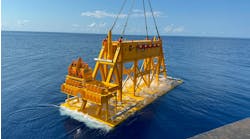John Waggoner - Technology Editor, Drilling & Production
Offshore oil and gas exploration and production activity in Latin America has been centered largely in Brazil following the discovery of massive presalt hydrocarbons that suggest the country will become a major exporter.
However, other countries such as Mexico and Venezuela have been inching closer to expanding offshore activity, but in both cases serious political issues remain to be resolved before heavy investment can take place.
With the exception of Brazil, the retreat of oil prices since the peak at $147/bbl in mid 2008 has tended to keep new projects in check. The current global recession and resulting evaporation of liquidity on the credit market also is seen by analysts as a stumbling block for the region.
However, the current economic scenario represents an opportunity for independent oil companies (IOCs), since the national oil companies which dominate oil and gas production in the region now need not only technology but also capital to transform state goals of expansion into reality.
Brazil
Brazil’s discovery remains very much an enigma in terms of the size of the reserves as well as regulatory issues. Estimates on the presalt reserves, which have yet to be defined by Petrobras, range up to a staggering 80 Bboe.
Brazil’s National Petroleum Agency plans to hold another oil and gas licensing round this year, but no offshore E&P blocks will be leased. The last such round, the 10th for Brazil, also excluded offshore blocks.
The reason is that Brazil is mulling new laws that would give the state a larger stake in oil and gas production from the presalt areas in new contracts. This raises concern from independents stung by nationalization in the region years before, but officials have sought to reassure the IOCs that existing contracts will be honored.
A government study group is preparing draft proposals for the legislature. One proposal forms a second state oil company specifically for the presalt reserves with production-sharing agreements modeled after Norway’s system.
Petrobras and Schlumberger have signed a technological cooperation agreement for presalt research and development. Included under the agreement are four research projects: Electromagnetic technologies to improve deep reservoir characterization; seismic data analyses technologies, also to improve reservoir characterization; nuclear magnetic resonance technologies, aimed to characterize complex reservoirs; and H2S electrochemical sensors. Additionally, six other projects still are under negotiation. The agreement will be in effect for three years, and can be renewed for an equal term. Petrobras foresees it will invest some $10 million in the projects.
Apart from expanding technology, Brazil views the presalt bonanza as a way to revive the sleeping giant of the once mighty local shipbuilding industry. Some analysts, however, have questioned the ability of startup companies to deliver so many rigs and semis, including 40 for Petrobras to deploy in 2013 to 2017.
New local independent OGX Petróleo e Gás Participações is initiating its exploratory campaign in the Campos and Pará-Maranhão basins. The company has implemented a 3D seismic campaign, hired four semisubmersible drilling rigs, and chartered six vessels and two helicopters for logistical support. The company also has contracted an onshore base and acquired drilling materials to support exploration and the construction of a state-of-the-art 3D visualization center. With strong capitalization and its experienced engineering team recruited selectively from Petrobras, the company is one to watch.
Here are some of the key highlights to watch in the months ahead:
- Local startup OGX has launched an ambitious drilling program
- Petrobras year-end oil production is expected to climb to 2.8 MMb/d reaching 3.7 MMb/d by 2013 and as much as 5.8 MMb/d by 2020
- First presalt oil was expected in May from the Tupi field in the Santos basin, operated by Petrobras. The start of long-term tests at Tupi will progressively ramp up through 2010 and provide more assurance about the presalt program
- Likely changes in the presalt regulatory framework
- New tenders by Petrobras for up to 28 newbuild drilling rigs postponed from 2008.
Mexico
Mexico is aware that existing oil reserves in the Campeche Bay and elsewhere will run out sooner or later, and IOCs are hoping this will lead to new opportunities.
President Felipe Calderon last year proposed to overhaul Pemex, including allowing the cash-strapped company to take on private oil firms as full partners in the exploration and drilling of new deepwater deposits in the Mexican sector of the Gulf of Mexico.
While there appears to be political will to change Mexico’s petroleum laws, a full fledged overhaul could require changing the country’s Constitution. Mexico’s nationalization of hydrocarbons in the last century remains a source of national pride, not to mention the main source of government revenues.
Given the public backlash against any step toward “privatization,” a production sharing agreement with Pemex ownership could be the eventual way forward, though it is not yet clear whether IOCs will agree to state control.
In the meanwhile, state-run Pemex plans to lease five offshore drilling facilities including a semisubmersible or drillship for deepwater in the Mexican sector of the Gulf of Mexico and four drilling rigs for shallow waters.
Opportunities exist for service companies with a strategy of partnering with NOCs. Halliburton late last year signed a $33.6-million contract to improve recovery rates offshore that will continue through 2010.
Pemex in March awarded a $58-million contract to Cal Dive International for pipeline installation in shallow water. The project in the Tabasco field offshore Mexico is scheduled to begin this month.
Venezuela
Venezuela needs partners to develop its offshore hydrocarbons. The government’s budget for this year foresees an average oil price of $60-70/bbl, severely squeezing public finances. To complicate the price environment, some IOCs hesitate to do business with state-run PDVSA because of regulatory uncertainties. This has led Venezuela to reach out to foreign NOCs as well as courting independents.
Eni has signed a letter of intent with PDVSA to explore and develop two offshore areas. The two areas, Blanquilla Est and Tortuga, are in the Caribbean Sea off the coast of Venezuela, approximately 130 km (81 mi) north of Puerto La Cruz. Water depths in the approximately 5,000 sq km (1,930 sq mi) covered by the agreement range from 200 to 500 m (656 to 1,640 ft). The companies believe that the two wells previously drilled on the area confirm a high potential for gas and condensate resources.
Development of the two areas will be an integrated business venture consisting of exploration, production, liquefaction, and marketing activities linked to a new LNG train. The first phase will cover exploration and reserve certification and will be carried out by a joint venture that includes PDVSA (20%), Eni (20%), and other partners. The second phase will be carried out by a mixed enterprise that includes PDVSA (60%), Eni (10%) and other partners. Reserves from the development will be dedicated primarily to the LNG facility, in which Eni will also have a 10% ownership.
Russia’s Gazprom is drilling the first offshore natural gas well in Venezuelan waters. PDVSA retains the exclusive right to produce natural gas in the country. The potential natural gas reserves of the two areas awarded to Gazprom, Urumaco I and Urumaco II, average 100 bcm (3.5 tcf).
Regulatory issues continue to cause concern in Venezuela. Petrosucre, a PDVSA subsidiary, has assumed control of drilling operations on the jackup ENSCO 69 in an ongoing dispute over past due invoices. When Petrosucre failed to pay, Ensco suspended drilling operations upon completion of the well in progress. Petrosucre told Ensco that it is taking over operations on the rig and that Ensco is free to terminate the contract and remove the rig if it wants.ENSCO 69 began its current contract with Petrosucre in August 2008.
Trinidad & Tobago
Repsol is increasing investments in Trinidad and Tobago. The company plans to bid in new offshore exploration rounds off the coast.
BHP Billiton (Trinidad-2C) has awarded J. Ray McDermott a contract for the Angostura gas export platform project offshore Trinidad.
Under the terms of the agreement, J. Ray will fabricate a 4,000-ton (3,629-metric-ton) integrated topside platform; an 800-ton (726-metric-ton), four-legged jacket; and 1,000 tons (907 metric tons) of piles. The construction of these structures will take place at J. Ray’s Morgan City, Louisiana, fabrication facility.
Work is expected to be completed in 2Q 2010.
Operator Canadian Superior in March began flow testing of the offshore Endeavour well in the Intrepid block 5(c). Initial tests showed a peak flow rate of 60.1 MMcf/d of gas, the maximum rate allowed under specifications. The tests showed dry gas with a gas gravity of some 0.584, about 0.3% CO2 with no production of water, condensate or solids.
Cuba
Brazilian NOC Petrobras and Companhia Cubana de Petróleo (Cupet) have a joint E&P agreement for block 37 offshore northern Cuba. The exploration phase will be divided into four periods ranging from 18 to 24 months each. At the end of each period, Petrobras will assess whether or not to remain in the deal. If the project finds oil, Cupet will have the option to participate by paying for past and future investments in field exploration, development, and production.
Falkland Islands (Malvinas)
FOGL and operator BHP Billiton have completed a series of site surveys on their license areas south and east of the Falkland Islands. TheMV Fugro Meridian conducted the surveys in four areas selected jointly by two partners.
The vessel, operated by Fugro Surveys, acquired data to be used to assess seabed stability, determine sites for rig anchors, and to provide a picture of probable seafloor habitats. In addition, numerous gravity cores and grab samples of the seafloor were recovered. In parallel, theMV Fugro Saltire undertook a geotechnical boring program of the subsurface sediment to assist in detailed design of conductors and casings for future wells. These designs will also form part of the regulatory approval.
Chile
The Direccion Nacional de Fronteras y Limites del Estado of Chile has awarded a Letter of Intent to SCAN Geophysical ASA for a 2D offshore seismic survey. SCAN’s dedicated 2D vessel, theM/V Geo Searcher using an 8,000 m (5 mi) solid streamer system combined with a 4,200 cu. in. source will acquire the approximate 1.5-month project, scheduled to end this month.
Colombia
Ecopetrol and BHP Billiton Petroleum Corp., through its Colombian subsidiary, have executed an agreement to increase Ecopetrol’s interest in the Fuerte Norte and Fuerte Sur blocks, both in the Colombian Caribbean Ocean. BHP Billiton will assign to Ecopetrol 25% of its participation in the two blocks, as a result of which each company will have a 50% interest in the blocks. The assignment of the interest by BHP Billiton to Ecopetrol requires approval by the ANH.
Peru
BPZ Resources is focusing on an oil development in the offshore block Z-1 in northwest Peru with a goal of doubling production and reserves this year.
The company plans to commit a majority of its capex to appraise and develop the oil in the Corvina and Albacora fields. BPZ has decided to keep the rig currently drilling at the CX-11 platform in place to drill three additional oil development wells this year. Additionally, the recently contracted rig scheduled for onshore block XIX, will instead be mobilized to the Albacora platform to drill two new wells beginning in 2Q 2009. Under this development plan, the company hopes to double production exiting 2009 at 12,000 b/d of oil.





